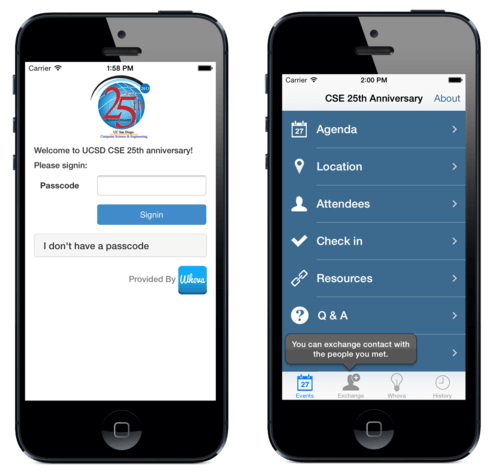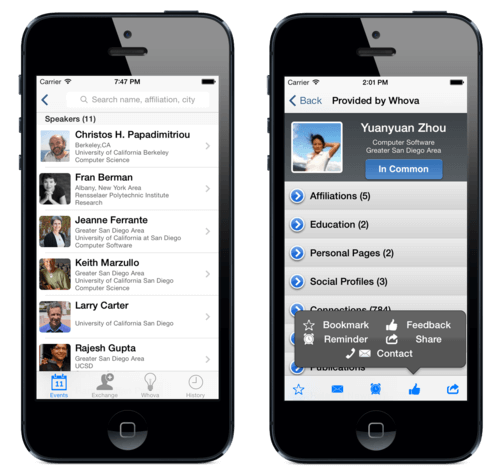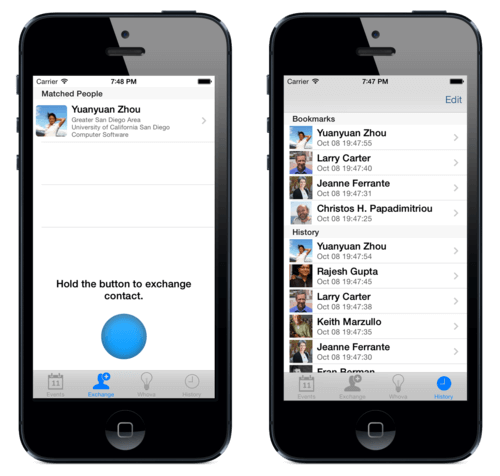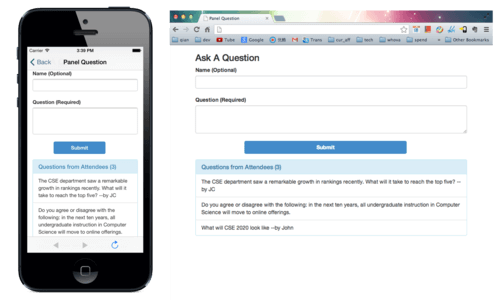In almost every profession, there are events like conferences, tradeshows, alumni gathering, fund-raising, etc. If you are like me who have little time to prepare for events in advance, you will find yourself wondering around, talking with random people, chatting about random things, sitting in some boring sessions. I often feel bad and guilty at the end because I did not fully leverage the networking opportunity provided by an event. After all, we only attend a major professional event once or twice per month, and sometimes we even pay money and travel away from work and family to attend such event. It is a pity that we cannot get more out of the event. I know I need to do something about this. But driven by deadlines, I never find time to do much preparation in advance, except maybe browsing the event material for a few minutes after registration. Interestingly, my own procrastination (or “itch”) has brought an interesting use case for Whova’s technology.
In early Sept, I received an email from CSE department about the CSE25th Anniversary Celebration Event. A random thought jumped out: why cannot we leverage Whova’s people information to build a special app for this event (and many other events in the future). Once we know the RSVP list, we can easily pull data from Whova database and provide background profile information about each attendee and speaker. By browsing attendee information, can we find whom we want to talk to? What do they look like? What do we have in common? We can also allow users to search for attendees from some particular affiliation (e.g. Qualcomm). Furthermore, we can add mobile-friendly agenda, event-related web links such as online streaming. And organizers can ask attendees to submit surveys on smartphones at any time (even after the event).
Of course, as the first step, I had to get my team’s support since I knew nothing about coding on iPhone and Android (those who cannot do teach). I pitched the idea to the team and they were all excited and supportive (Yeap, as a professor, I am semi-trained in pitching ideas, especially in front of young people). With them on board, I contacted with our CSE department Chair, Professor Rajesh Gupta. He replied immediately and really liked the idea. The second day, we had a meeting with the organizers. Everyone liked this app idea but was also worried since it was only 1 month away from the event. Are we able to get the app done by then? Do we have enough time to build the app for both iPhone and Android? What if Apple’s AppStore rejects our app? (by the way, it did happen to us unfortunately. We will tell you this story and our painful experience soon in a future blog.)
In our discussion with the organizers, additional features also came up:
- (1) Allowing audience to use our app to do Q &A (question and answering) in sessions. It turned out this feature is really useful for panel sessions because each panelist has a choice to answer the question selected by the panel moderator or any other question submitted by audience (all questions submitted by audience also show up in the projected screen in real time). It makes the panel discussion less boring (after all, after 2-3 panelists answer a question, it is very hard for the 4th or 5th to add anything interesting to the same question).
- (2) Providing direction to the event with just one click of the button. Very often, it is not easy for people to find the event location, especially if it is in a big campus like UCSD, or is in a big conference room only known to the internal people.
- (3) Allowing attendees to exchange their profile information easily.
After 3 weeks of day-and-night crunching, the team released the apps for both iPhone and Android (sorry, no app for Microsoft Phones). The first day after the organizer sent out emails to all the RSVPed people, we got almost 100 downloads. And the second day we had 100 downloads. On the third day (the event day), there were about 250 downloads – pretty much, 80% of the attendees have downloaded our apps. At the event, we were all nervous (worrying about the stability of the back-end servers ) and also at the same time excited. One of us commented that day as his happiest day in 2 years. This comment made me, his “boss”, happy and also a little depressed 🙂
The CSE department also did a news article about our app.
“CSE 25th Anniversary Celebration Marks Debut of New Mobile App“
At the end of the event, some of the attendees submitted their surveys. In addition to those specific to the event and CSE, we also added three questions about our app:
- (1) Question: “Do you like the app and will recommend it for future events?”
Survey Result: Every returned survey answered yes. This is very encouraging for us. - (2) Question: “What do you like the app the most about this app?”
Survey Result: 50% of them liked the convenience of accessing the event information in one place in a mobile friendly way with just a few clicks, and the remaining liked the profile exchange feature.
In case you are wondering what the profile exchange feature, the rest of this article briefly describes a few major features of our app:
1. Top menu

Because we know people care about privacy, we made the app accessible by a passcode which has been distributed only to the RSVPed people. If anyone forgets to the passcode, we send the passcode to her email that was used for RSVP.
Once we get into the app, from the top menu, we can browse various information, such as the event agenda, direction to the event location, attendee list and their information, and other useful links (Resources). By doing “check in” with our names, which is similar to what we do in the Foursquare or Facebook, we can claim we are actually attending in the event and also see who are in the event. On the top menu, there are two other features: Q & A support (see below) and collecting survey answers.
2. Attendees’ Information

We can easily search for a person by her name or a keyword such as an affiliation name and a city name, as well as see the lists of speakers, special guests, faculty/staff, students, and checked-in users. For each attendee, we show a Whova profile of the person, which includes affiliation, education, personal pages like homepages and bios, social profiles, connections inferred from many web sites, publication, and other web pages related to the person.
Then, how can we leverage this information for better networking during an event? From the profiles, we can get various topics to talk about and easily break the ice. We can see what she is working on, what is her role and recent achievement, what is her interests, whether she moved a job recently, what she twitted about. It is so easy and quick – we can browse her homepage, social network sites, publication, news/blogs, etc., just by clicking her profile. At a glance, we can also see who among our colleagues and friends are connected to her or may know her (if they have worked together, been mentioned in the same news/homepage, or written papers together), and this can be a good topic to start a conversation.
3. Profile Exchange

Instead of exchanging business cards, we can exchange Whova profiles by doing a fun activity with our new acquaintances for a few seconds. The app allows us to exchange each other’s Whova profile by pushing the blue button on the screen at the same time until the two devices are synced up. The profiles will be automatically bookmarked in each other’s app and we can follow up the person after the event. It has the same (or even better) effect that we manually search for the person’s information on internet after finding out his business card from our pockets filled with full of cards we exchanged during the event, read all the web pages returned and identify which are really talking about the person not about the others with the same name, and bookmark the multiple web pages one by one.
4. Q &A

Everybody can easily pose their questions to speakers through the app during talks and panel sessions. The questions from audiences are shown in the shared message board on the bottom of the app in real time so that all attendees can see them. Some good questions may inspire the other good ones. Of course, we can avoid duplicate questions.
Even more conveniently, the message board is synced up with a particular web page so that it can be displayed on a large screen on the stage. A session organizer and panelists can see various questions at a glance and select interesting questions and comments. Panelists can select different questions from the pool, audiences can share their ideas at any time without interrupting other people’s talk, and an organizer can lead the time-limited session to be more interesting. It is a fun and convenient communication channel for speakers / panelists / organizers and audience.
